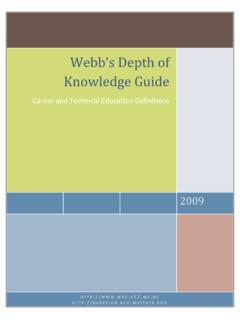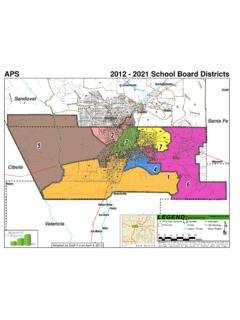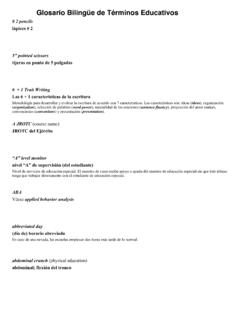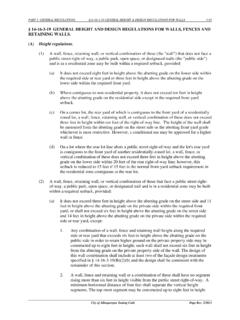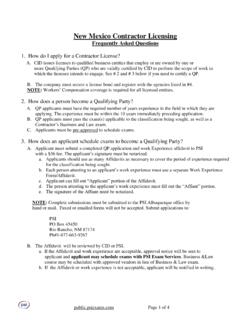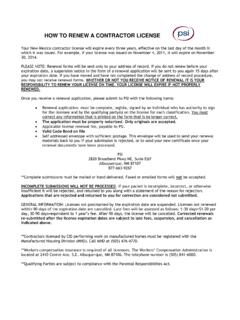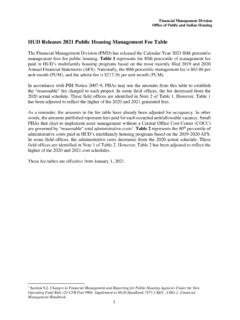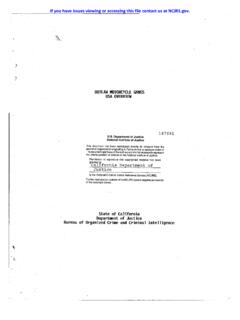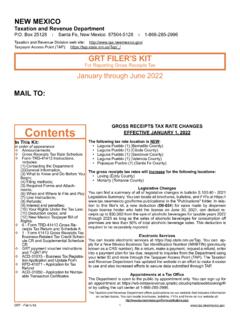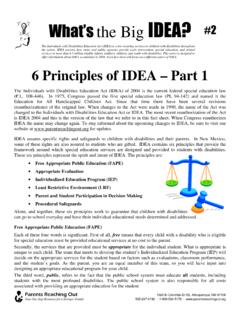Transcription of Overview of Unit 3 The Issue of Renewable Energy
1 Overview of Unit 3 The Issue of Renewable EnergyIntroductionThere has been considerable interest recently in the topic of Renewable Energy . This is primarily due to concerns aboutenvironmental damage (especially acid rain and global warming) resulting from the burning of nonrenewable fossilfuels. However, investing in Renewable Energy is controversial for several reasons. First, not all scientists agree on thedegree of environmental damage that can be attributed to fossil fuels. Second, fossil fuels are relatively abundant andcheap Energy sources, and have contributed significantly to economic growth. Abandoning inexpensive fossil fuels formore expensive Renewable ones will have major economic ramifications. Your students will enjoy analyzing thisinteresting and controversial ObjectivesAfter completing this unit, students to examine an Energy /environmental Issue using a five-step, decision-making basic facts about various Renewable Energy the advantages and disadvantages of Renewable Energy basic economic concepts used to analyze Energy that public policy decisions involve trade-offs among social about Renewable Energy Energy Energy in Research and Development (R & D) the Actions: You Can Make a Difference!
2 To Selected Teaching ActivitiesFacts About Renewable EnergyIntroductionIn the 1970s and early 1980s, there was great national interest in Energy policy and Energy conservation. This wasprimarily due to the huge increase in the price of oil, caused by reductions in oil supplies as a result of the OPEC oilembargo in 1973 and the Iranian hostage crisis in 1979. The higher price for oil spurred private and governmentaldevelopment of Renewable Energy sources such as, solar power, wind, geothermal, and biomass. In the late 1980s,however, the national commitment to Renewable Energy waned as the price of oil plummeted. Neither the government,nor consumers, were willing to invest in more costly Renewable Energy sources and programs when nonrenewablefossil fuels were so recent years, there has been a greater interest in the Issue of Energy , especially Renewable Energy .
3 This interest hasnot been the result of rapidly increasing Energy prices nonrenewable Energy , including oil, is abundant and relativelyinexpensive. Rather, the renewed interest has been because of environmental concerns, especially the burning of fossilfuels, which many believe contributes significantly to acid rain and global warming. Another factor contributing to theinterest in Energy issues is the realization of the United States increasing dependence on foreign oil. This washighlighted by the war in the Persian policy issues involving Energy have tremendous economic implications. To ensure wise public policy, citizensand decisiomnakers must not only understand basic facts about Energy sources, but also must know how to apply basiceconomic concepts in their analysis of Energy BasicsMEASURING Energy : Energy can be defined as the capacity to do work.
4 The unit ofmeasurement used to express the heat contained in Energy resources is called a Britishthermal unit or Btu. One Btu is the heat Energy needed to raise the temperature of onepound of water one degree Fahrenheit. A Btu is quite small. For example, if allowed toburn completely, a wooden kitchen match gives off one Btu of Energy . A quad is used tomeasure very large amounts of Energy . A quad is equal to one quadrillion(1,OOO,OOO,OOO,OOO,OOO) Btu s. The United States uses an enormous amount ofenergy about one quad of Energy eveiy days! Energy SOURCES: There are many primary Energy sources used in the United States, including petroleum, coal,natural gas, nuclear, hydropower, propane, geothermal, wind, solar, and biomass. Figure 3-1 shows the breakdown byenergy Consumption of Primary Energy (1991)(Percent)Hydropower, Geothermal, and Other - primary Energy sources are classified as Renewable or nonrenewable.
5 Renewable Energy sources are those thatcan be replenished quickly or that are nondepletable. Examples include solar, hydropower, wind, geothermal, andbiomass. Nonrenewable Energy sources are finite. If we continue to use them, at some point they will run are fossil fuels such as coal, petroleum, and natural : Electricity is a secondary Energy source, which means that we must use primary sources to produceit. About 28 percent of all primary Energy consumed in the United States is used to generate electricity. Coal, nuclear,hydropower, natural gas, and petroleum are the top five primary sources for producing electricity. Unlike the primarysources, electricity is not classified as Renewable or IN UNITED STATES Energy CONSUMPTION: As the economy and population of the United Stateshave grown, so has Energy consumption.
6 However, this increase has been marked by remarkable increases in energyefficiency. For example, in 1989, the United States used about 9 percent more Energy that it did in 1973; however, thevalue of the nation s real gross domestic product GDP (the total value of all the goods and services produced in theeconomy in a year) was 46 percent higher! The United States has improved its Energy /GDP ratio as fast or faster thanother developed countries. This improvement in Energy efficiency was largely a response to the rapid increases incrude oil prices in the Energy SourcesRECENT TRENDS: In the 1970s, the federal government s Renewable Energy program grew rapidly to include notonly basic and applied research and development (R & D), but also participation in private sector initiatives.
7 In the1980s, this interest waned as the price of oil fell. In constant dollar (real) terms, government spending for R&D inrenewable Energy declined 90 percent from a peak of $875 million in 1979 to a low of $84 million in 1990. In 1990,this trend was reversed. Constant dollar R&D spending in 1992 was $146 million, and it appears likely there will beadditional funding for additional Renewable Energy programs. This funding increase reflects fears of environmentaldamage from burning fossil fuels, especially acid rain and global what extent the United States continues to subsidize the development of Renewable Energy will be a subject ofmuch future Energy SOURCES: The information below identifies basic facts about the different renewableenergy sources, and lists some advantages and disadvantages of each Energy : Solar Energy is produced in the core of the sun.
8 In a process called nuclear fusion, the intense heat inthe sun causes hydrogen atoms to break apart and fuse together to form helium atoms. A very small amount of mass islost in this process. This lost matter is emitted into space as radiant Energy . Less than 1 percent of this Energy reachesthe earth, yet it is enough to provide all of the earth s Energy needs. The sun s Energy travels at the speed of light,186,000 miles per second, and reaches the earth in about eight minutes. Capturing the sun s Energy is not easy, sincesolar Energy is spread out over such a large area. The Energy a specific land area receives depends on factors such astime of day, season of the year, cloudiness of the sky, and proximity to the primary use of solar Energy is home heating.
9 There are two basic kinds of solar heating systems: active andpassive. In an active system, special equipment (such as solar collectors) is used to collect and distribute the solarenergy. In a passive system, the home is designed to let in large amounts of sunlight. The heat produced from thelight is trapped inside. A passive system does not rely on special mechanical primary use of solar Energy is producing electricity. The most familiar way is using photovoltaic (PV)cells, which are used to power toys, calculators, and roadside telephone call boxes. The other primary way to produceelectricity is using solar thermal systems. Large collectors concentrate the sunlight onto a receiver to superheat aliquid, which is used to make steam to power electrical of Solar Energy Unlimited supply Causes no air or water pollutionDisadvantages of Solar Energy May not be cost effective Storage and backup are necessary Reliability depends on availability of sunlightHydropower Hydropower is Energy that comes from the force of moving water.
10 Hydropower is a Renewable energysource because it is replenished constantly by the fall and flow of snow and rainfall in the water cycle. As water flowsthrough devices such as a water wheel or turbine, the kinetic (motion) Energy of the water is converted to mechanicalenergy, which can be used to grind grain, drive a sawmill, pump water, or produce primary way hydropower is used today in the United States is to produce electricity. In 1991, hydropowerprovided 10 percent of the nation s electricity. Although a hydroelectric power plant is initially expensive to build, inthe long run, it is the cheapest way to produce electricity, primarily because the Energy source, moving water, is , many people have built smaller hydroelectric systems that produce only enough electricity to power a fact sheets for middle and high school students on all the Renewable and nonrenewable Energy sources areavailable from the National Energy Education Development Project (NEED), 102 Elden St.

